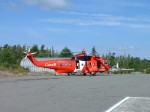
In the days before portable radios and instant communications, we were always apprehensive about the day we headed out for holidays.
First there was the weather which as everone knows on the West Coast of Canada is always unpredictable even with modern weather forecasting. We observed the weather but rarely got any weather forecasts.
Next came the Coast Guard. Our long-awaited flight could be diverted for search and rescue, maintenance, or any of a hundred other reasons.

In those days too, to save money, the assistant and his family had to go off station on leave in coordination with the senior keeper. By this I mean, when the senior decided to go off station for his annual leave, we, as assistants, had to either go before him or after him so that the helicopter was not flying empty too many times which kept the costs down. It also meant that the relief keeper was not being transported randomly all over the countryside but could count on at least two months or more residence and pay at one station.

Before the days of numerous Coast Guard helicopters1, the flights were usually arranged by private helicopter companies such as Vancouver Island Helicopters (VIH) in Port Hardy, BC. In later years the Coast Guard provided helicopters for our transportation. Helicopters such as the MBB-105, Sikorsky S-61N or Bell 212. One of the earliest heliocpters we flew in was the Bell 47 which took us into our first station at Pulteney Point in 1969. It was used on the CG ice breakers as an ice spotting aircraft.
The day of departure!
Suitcases packed, children ready, house all sorted out for the relief keeper to move in, notes left on plant watering, animal feeding, fuel tanks filled, drinking water checked. Also a meal left for the relief keeper if this was his primary arrival at the station.

The relief keeper was usually well known to us but at times we had to leave our house in charge of unknown keepers that Coast Guard had hired on the spot to fill the position because no one else was available. The relief keeper lived in whichever keeper’s house was vacant at the time. I always had the best of rapport with the many relief keepers we had. In fact, we used to say “the house was cleaner when we came back that when we left” with most of them.
Get the tractor and trailer out and load all the bags for the expected arrival. This arrival time was usually relayed from the local Coast Guard radio station when we gave the last weather report. Now all we had to do was wait! And wait! And wait!
If the weather was good then we waited by the helicopter pad, searching the sky in the direction from which we knew it must come. “There it is” shouted one of the children. “There! There!” with their fingers pointing excitedly in the required direction. We searched the sky until our eyes blinked in pain. The children always had better eyes. “THere it is! I shouted, pointing in the same direction. About 10 miles out!”
“That’s a seagull”, said Karen who had better eyes than myself. “Nah, it’s the chopper.” “Nope, a seagull” and sure enough, it wheeled and dove and disappeared from sight. This sometimes happened so many times your eyes watered.
Finally, one of the seagulls stayed steady on course and grew increasingly larger. Depending on the planning we either greeted the relief keeper and all his gear or the returning senior keeper.
Quickly unloading, loading, and up and away! We were going out on leave, unbelievably on the scheduled day!
**********************
FOOTNOTE:
1 In the early years (pre-helicopter) most keepers and their families were transported on holidays via the Coast Guard supply ships. Here is Reg Gunn’s excellent article as mate on one of the work boats used to bring the passengers to the ship.